
Laboratory Investigations in Microbiology

 |
Laboratory Investigations in Microbiology |
 |
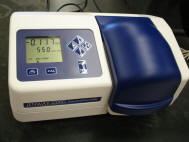 A spectrophotometer is an instrument which passes a beam of light through a
liquid and measures how much of this light is absorbed by the liquid. The absorbance
of a liquid is useful to know in several instances. For liquid bacterial
cultures (broths) the absorbance is directly proportional to the
cloudiness of the broth and therefore is a measure of the number of bacteria in
the broth. For pigments, the absorption spectrum can help in identifying
the type of pigment and the wavelengths of light it absorbs best.
A spectrophotometer is an instrument which passes a beam of light through a
liquid and measures how much of this light is absorbed by the liquid. The absorbance
of a liquid is useful to know in several instances. For liquid bacterial
cultures (broths) the absorbance is directly proportional to the
cloudiness of the broth and therefore is a measure of the number of bacteria in
the broth. For pigments, the absorption spectrum can help in identifying
the type of pigment and the wavelengths of light it absorbs best.
Different models of spectrophotometers vary in how they are calibrated, but in essence the instructions are basically the same:
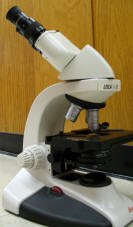
Our laboratory is equipped with (new in 2007) Leica DM-E binocular light microscopes, fitted with 4x, 10x, 40x, and 100x objective lenses for magnification ranging from 40 - 1000-fold. These microscopes feature the following controls:
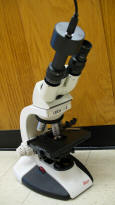 Digital cameras for microscopes
Digital cameras for microscopesEach lab station will have use of a DM300 digital microscope camera, allowing you to capture still images of what you are looking at. The camera works in association with the ScopePhoto software on your lab station computers.
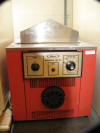
Water baths are used to bring culture media and cultures to a specified temperature. The set point of each water bath can be as high as ~ 100°C. These water baths are useful for high-temperature incubations (e.g. growth experiments at temperatures of 55°C, 65°C etc. ) and for keeping agar media liquid before pouring them into Petri plates.
There are two large walk-in incubator in the rear of the autoclave/glasswash area (Hudson 220A), set to a temperature of 30°C (left) and 35°C (right). Thess temperatures are ideal for the culture of most laboratory strains of bacteria and will be used for most of our experiments. Other, smaller incubators in the side of the lab are used for other incubation temperatures as needed.
There are several pH meters used to measure and adjust the acid/base balance of solutions.
An autoclave is an instrument used to sterilize culture media, plastic lab supplies such as pipette tips, and to sterilize all lab supplies prior to cleaning and disposal at the end of an experiment. Autoclaves heat materials to a temperature of ~ 121°C at a pressure of 103 kPa. This temperature and pressure kills all microbes - viruses, bacteria, spores and fungi (except one strain of Archaea!). The autoclave is located in Hudson 222A.
Bunsen burners are widely used in Microbiology to sterilize, heat-fix, and help to maintain a relatively germ-free work zone at the lab bench. The gas valves in this room are in the "ON" position when the handle is parallel to the spout, and "OFF" if the handle is at 90 degrees (on either side) of the spout. Turn the handle on, then use either a striker or a grill lighter to ignite the gas. Adjust the flame so that there is a bright blue inner cone, a darker blue outer cone, and no yellow flame visible. Adjust the flame to a height of ~ 6". The area of highest temperature is just above the bright blue inner cone.
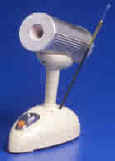 An alternative to using a Bunsen burner when sterilizing inoculating loops
and needles, the Bacti-cinerator produces the high temperatures for sterilizing
the metal wire in a hollow ceramic chamber. Allow the chamber to warm up for 10
minutes before using. Once it is warmed up, hold the loop or needle wire into
the chamber for 5 seconds for complete sterilization. The Bacti-cinerator may be
left on all day and avoids the hazard of an open flame in the
laboratory. We will use the bacti-cinerators for most of the
experiments this semester.
An alternative to using a Bunsen burner when sterilizing inoculating loops
and needles, the Bacti-cinerator produces the high temperatures for sterilizing
the metal wire in a hollow ceramic chamber. Allow the chamber to warm up for 10
minutes before using. Once it is warmed up, hold the loop or needle wire into
the chamber for 5 seconds for complete sterilization. The Bacti-cinerator may be
left on all day and avoids the hazard of an open flame in the
laboratory. We will use the bacti-cinerators for most of the
experiments this semester.
 Micro-pipetters are precision instruments which allow the accurate pipetting
of small volumes of liquid. They are fragile and expensive, so please handle
these with great care! There are different sizes of micro-pipetters. The two
sizes we will use in this lab are the P-1000 (pipets up to 1000 microliters = 1
ml) and the P-200 (pipets up to 200 microliters, or 0.2 ml). The P-1000
pipetters have a blue knob at the top and are inscribed with the range (1000
- 100). The P-200 pipetters have a yellow knob and are inscribed with the range
(200 - 20). To use the pipetters:
Micro-pipetters are precision instruments which allow the accurate pipetting
of small volumes of liquid. They are fragile and expensive, so please handle
these with great care! There are different sizes of micro-pipetters. The two
sizes we will use in this lab are the P-1000 (pipets up to 1000 microliters = 1
ml) and the P-200 (pipets up to 200 microliters, or 0.2 ml). The P-1000
pipetters have a blue knob at the top and are inscribed with the range (1000
- 100). The P-200 pipetters have a yellow knob and are inscribed with the range
(200 - 20). To use the pipetters:
 A vortexer is used for
mixing solutions and suspensions in test tubes. It is especially useful when you
want to get the bacteria in a test tube to be evenly mixed in the tube. You use
the vortexer by holding the test tube near the top, with one finger on the cap,
and lightly pressing the bottom of the tube into the cup of the vortexer
until it starts. Make sure you are holding on tight to the test tube!
A vortexer is used for
mixing solutions and suspensions in test tubes. It is especially useful when you
want to get the bacteria in a test tube to be evenly mixed in the tube. You use
the vortexer by holding the test tube near the top, with one finger on the cap,
and lightly pressing the bottom of the tube into the cup of the vortexer
until it starts. Make sure you are holding on tight to the test tube!
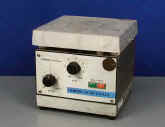 Hotplates are used
in the laboratory for heating solutions. This is important in Microbiology when
you make culture media because agar needs to be heated to ~80C before it
will dissolve. (Note: Broths do not need to be heated) Heating may also be used
to try to pasteurize or sterilize liquids. Many hotplates have a built-in
magnetic stirrer that will keep your liquid stirring (using a magnetic stir-bar
that is placed into your beaker or flask).
Hotplates are used
in the laboratory for heating solutions. This is important in Microbiology when
you make culture media because agar needs to be heated to ~80C before it
will dissolve. (Note: Broths do not need to be heated) Heating may also be used
to try to pasteurize or sterilize liquids. Many hotplates have a built-in
magnetic stirrer that will keep your liquid stirring (using a magnetic stir-bar
that is placed into your beaker or flask).
© 2003 - 2017 José de Ondarza, Ph.D.